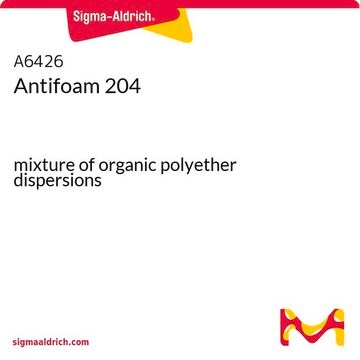All Photos(1)
About This Item
CAS Number:
MDL number:
UNSPSC Code:
12162002
PubChem Substance ID:
NACRES:
NA.23
Recommended Products
form
liquid
mol wt
Mn 1513
refractive index
n20/D 1.451
viscosity
~450 mPa.s(20 °C)
solubility
water: miscible (completely)
density
1.00 g/mL at 20 °C
InChI
1S/C6H14O3/c1-5(8)4-9-6(2)3-7/h5-8H,3-4H2,1-2H3
InChI key
DUFKCOQISQKSAV-UHFFFAOYSA-N
Looking for similar products? Visit Product Comparison Guide
General description
Polypropylene glycol is an addition polymer of propylene glycol and water. It is represented by the formula HO(C3H6O)nC3H6OH in which n represents the average number of oxypropylene groups. Polypropylene glycol is soluble in water and in certain organic solvents as aliphatic ketones and alcohols and insoluble in ether and in most aliphatic hydrocarbons.
Application
Polypropylene glycol (PPG)is widely used as an antifoaming agent. For example, it can be used to controlfoam in the production of Bacillus thuringiensis-based biopesticides fromsewage sludge.
It can be used in thepreparation of polyurethane(PU) elastomers. For example, it can be used tosynthesize PU elastomers with good acoustic absorption properties.
PPG-2000 can be used as a soft segment in the preparationof PU-based self-healing polymeric networks. These networks find application in the field of soft electronics.
It can be used in thepreparation of polyurethane(PU) elastomers. For example, it can be used tosynthesize PU elastomers with good acoustic absorption properties.
PPG-2000 can be used as a soft segment in the preparationof PU-based self-healing polymeric networks. These networks find application in the field of soft electronics.
Features and Benefits
- Long and flexible alkyl groups promotechain mobility, which facilitates rapid self-healing.
- The methyl groups present on the sides of thepolymer improve emulsification in water.
Storage Class Code
10 - Combustible liquids
WGK
WGK 1
Flash Point(F)
445.0 °F - closed cup
Flash Point(C)
229.44 °C - closed cup
Personal Protective Equipment
dust mask type N95 (US), Eyeshields, Gloves
Certificates of Analysis (COA)
Search for Certificates of Analysis (COA) by entering the products Lot/Batch Number. Lot and Batch Numbers can be found on a product’s label following the words ‘Lot’ or ‘Batch’.
Already Own This Product?
Find documentation for the products that you have recently purchased in the Document Library.
Customers Also Viewed
Celeste R Brennecka et al.
Journal of biomedical materials research. Part B, Applied biomaterials, 100(5), 1298-1309 (2012-04-20)
This study examines the in vitro characteristics of a crosslinking polymer system for cerebral aneurysm embolization. The polymeric material is composed of poly(propylene glycol)diacrylate (PPODA) and pentaerythritol tetrakis(3-mercaptopropionate) (QT), formulated with the liquid contrast agents Conray™ or Omnipaque™ 300. The
Jessalyn Cortese et al.
Journal of the American Chemical Society, 134(8), 3671-3674 (2012-02-11)
We show here that complementary interactions can suppress mesoscopic order and thus lead to a counterintuitive change in material properties. We present results for telechelic supramolecular polymers based on poly(propylene oxide) (PPO), thymine (Thy), and diaminotriazine (DAT). The self-complementary systems
Chih Hao Chang et al.
Bio-medical materials and engineering, 22(6), 373-382 (2012-11-02)
Segmented polyurethane (SPU) materials based on different soft-segment component (PPG, PTMO and PBA) and various length of soft-segment (molecular weight of PBA: 500, 700 and 1000) were synthesized in this research. The soft-segment components were synthesized from polyether-polyols (PPG and
Zhiyong Zhao et al.
Chemical communications (Cambridge, England), 48(78), 9753-9755 (2012-08-25)
The designed DNA sequences can make DNA-b-PPO undergo in situ transition between diblock and triblock upon pH changes, consequently, induce a morphology-shifting from spherical micelles to nanofibers. This process is reversible and the assembled structures have been characterized by CD
Claudio Poggio et al.
Journal of endodontics, 38(9), 1239-1243 (2012-08-16)
The objective of this study was to evaluate and compare in vitro the decalcifying capability on root canal dentin of 4 different irrigating solutions. Twenty-five freshly extracted maxillary central incisors were selected. The canals were prepared to obtain a total
Our team of scientists has experience in all areas of research including Life Science, Material Science, Chemical Synthesis, Chromatography, Analytical and many others.
Contact Technical Service





